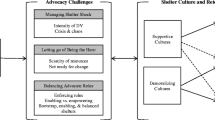General Conclusions
In this study, organizational age predicted the structure of women's shelters more powerfully than did ideological differences among shelters; even interactions between ideology and age were unimportant. Thus the findings appear to support organizational theory (e.g., Katz & Kahn, 1978; Miller, 1978) and to contradict assumptions that ideology can importantly influence structural development (e.g., Meyer, 1982; Schechter, 1982). These conclusions, however, should be qualified by the recognition that only women's shelters were studied. Far greater variation in structural development might be revealed by study of a broader range of organizations with more diverse ideologies.
Still in regard to shelters, the demands for systemic change to accommodate development did predominate over the demands associated with variation in shelter ideology. At one level, these results supported organizational theory. At a practical level, the results provided an empirical description of a basis for that organizational phenomenon that is commonly called “selling out.” Consultants' jobs may sometimes require alleviating tendencies among members of a system to blame one another for systemic processes that are, indeed, more productively described in terms of organizational development than in terms of ideological failure.
Similar content being viewed by others
References
Baker, A. (1982). The problem of authority in radical movement groups: A case study of a lesbian-feminist organization.Journal of Applied Behavioral Sciences, 18, 323–341.
Blake, R. R., & Mouton, J. S. (1972).Consultation. Reading, MA: Addison-Wesley.
Center for Women and Policy Studies. (1983). Federal budget cuts jeopardize domestic violence programs; A national survey report.Response- to-violence in the family and sexual assault (Vol. 6(3), pp. 1–40). Washington, DC: Author.
Claerhout, S., Elder, J., & Janes, C. (1982). Problem-solving skills of rural battered women.American Journal of Community Psychology, 10, 605–612.
Cohen, J. & Cohen P. (1983).Applied multiple regression/correlation analysis for the behavioral sciences (2nd ed.) Hillsdale, NJ: Erlbaum.
Dixon, G., Johnson, C., Leigh, S., & Turnbull, N. (1982). Feminist perspectives and practice. In G. Craig, N. Derricourt, & M. Loney (Eds.),Community Work and the state (pp. 59–72). Boston: Routledge and Kegan Paul.
Ferraro, K. (1981). Battered women and the shelter movement. Unpublished doctoral dissertation, Arizona State University.
Ferraro, K. (1983). Negotiating trouble in a battered women's shelter.Urban Life, 12, 287–306.
Goodstein, L. D. (1978).Consulting with human services organizations. Reading, MA: Addison-Wesley.
Joreen (1973). The bitch manifesto. In A. Koedt, E. Levine, & A. Rapone (Eds.),Radical feminism (pp. 50–59). New York: Quadrangle Books.
Katz, D, & Kahn, R. (1978).The social psychology of organizations (2nd ed.). New York: Wiley.
Lawrence, P., & Lorsch, J. (1967).Organization and environment. Homewood, IL: Irwin-Dorsey.
Leghorn, L. (1978). Grassroots services for battered women: a model for long term change.In Battered women: Issues of public policy (pp. 444–463). Washington, DC: U. S. Commission on Civil Rights.
Maslach, C., & Jackson, S. (1982). Burnout in health professions: A social-psychological analysis. In G. Sanders & J. Suls (Eds.),Social psychology of health and illness. Hillsdale, NJ: Lawrence Erlbaum.
McNeely, R. (1983). Organizational patterns and work satisfaction in a comprehensive human service agency: An empirical test.Human Relations, 36(10), 957–972.
McNeely, R., & Jones, R. (1980). Refuge from violence: Establishing shelter services for battered women.Administration in Social Work, 4(4), 71–82.
Meyer, A. (1982). How ideologies supplant formal structures and shape responses to environments.Journal of Management Studies, 19, 45–59.
Miller, J. (1978).Living systems. New York: McGraw-Hill.
Mitchell, R. & Hodson, C. (1983). Coping with domestic violence: Social support and psychological health among battered women.American Journal of Community Psychology, 11, 629–654.
Morgan, P. (1981). From battered wife to program client: The state's shaping of social problems.Kapitalistate, 9, 17–39.
Pahl, J. (1985). Refuges for battered women: Ideology and action.Feminist Review, 19, 25–43.
Peterson, P. & Bond, M. (1985, Winter). Grassroots feminist organizations: Issues for consultants.American Psychological Association, Division 27 Newsletter, pp. 15–16.
Porter, E., Lawler, E., III, & Hackman, J. (1975).Behavior in organizations. New York: McGraw-Hill.
Reinharz, S. (1983). Consulting to the alternative work setting: A suggested strategy for community psychology.Journal of Community Psychology, 11, 199–212.
Riger, S. (1984). Vehicles for empowerment: The case of feminist movement organizations.Prevention in Human Services, 3, 99–117.
Roberts, A. (1981).Sheltering battered women: A national study and service guide. New York: Springer.
Rothschild-Whitt, J. (1979). The collectivist organization: An alternative to traditional bureaucrat ic models.American Sociological Review, 44, 509–527
Sashkin, M., & Morris, W. (1984).Organizational behavior. Reston, VA: Reston Publishing.
Schechter, S. (1982).Women and male violence: The visions and struggles of the battered women's movement. Boston: South End Press.
Silvern, L. (1987).Traumatized Children of Violent Marriages. Unpublished manuscript, University of Colorado.
Tannenbaum, A. S. (1966).Social Psychology of the work organization. Belmont, CA: Wadsworth.
Thomas, K. (1976). Conflict and conflict management. In M. D. Dunnette (Ed.),Handbook of Industrial and Organizational Psychology (pp. 889–935). Chicago: Rand-McNally.
Author information
Authors and Affiliations
Additional information
The authors acknowledge the help of the following people who made this research possible: to Joan Welsh, former chairperson for the National Coalition Against Domestic Violence and former executive director of Boulder County Safehouse for her suggestions and help reaching shelters, to Gary McClelland for statistical consultation, to Jane Slaughter for assistance in data collection and data analysis, to William Hodges for helpful comments on an earlier draft, to the University of Colorado Psychology Department Phonathon Committee, who allocated funds for data collecotion, and to all the shelter idirectors who cooperated in completing the surveys.
Rights and permissions
About this article
Cite this article
Epstein, S.R., Russell, G. & Silvern, L. Structure and ideology of shelters for battered women. Am J Commun Psychol 16, 345–367 (1988). https://doi.org/10.1007/BF00919375
Issue Date:
DOI: https://doi.org/10.1007/BF00919375



